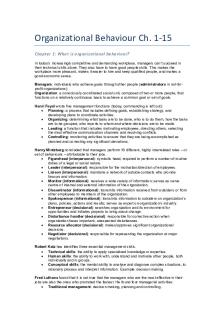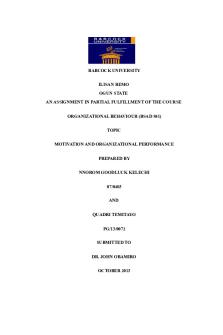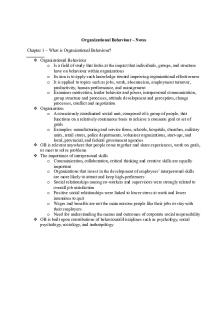Summary Organizational Behaviour - chapters 1-5 PDF

| Title | Summary Organizational Behaviour - chapters 1-5 |
|---|---|
| Author | Patricia Tumbocon |
| Course | Management And Organizational Behaviour |
| Institution | The University of British Columbia |
| Pages | 40 |
| File Size | 1.1 MB |
| File Type | |
| Total Downloads | 9 |
| Total Views | 148 |
Summary
chapters 1-5...
Description
What is Organizational Behavior?
Chapter 1
DEFINING WHAT ORGANIZATIONAL BEHAVIOR IS
Organizational behavior – field of study that looks at the impacts of individuals, groups, and structure have on behavior within organizations
Behavior – what people do in an organization and how they perform
Applied to jobs, absenteeism, turnover, productivity, motivation, working in groups, job satisfaction
What Do We Mean by Organization?
Organization – consciously coordinated social unit composed of a group of people that functions on a relatively continuous basis to achieve a common goal
OB is for Everyone
Study of OB is not only for leaders and managers
Employees can play a more proactive role in achieving organizational success
Roles of managers and employees are becoming blurred
Relevant anywhere that people come together and share experiences
The Importance of Interpersonal Skills
Importance of the role that an understanding of human behavior plays in determining organizational effectiveness
Developing interpersonal skills – closely tied to need for organizations to get and keep high-performing employees (who are always in short supply)
Reputations as good places to work – big advantage can result in superior financial performance
Wages and benefits – not main reason people like their jobs o
Quality of employee’s job and supportiveness of the work environment what keeps people around
Technical skills – necessary but not enough to succeed
TODAY’S CHALLENGES IN THE CANADIAN WORKPLACE
Three level analysis (basic OB model): Individual level Group level Organization systems level o
Each is constructed upon the previous
Challenges at the Individual Level
Individual Differences o
Each have certain characteristics that influence their behavior – personality, perception, values, attitudes
o
Organization can do little to alter them
Job Satisfaction o
Satisfied employees = more productive
o
Satisfaction – legitimate objective of an organization – should provide challenging jobs and reward intrinsically
o
Negatively related to absenteeism and turnover (costs a lot annually)
Motivation o
Manager should motivate different types of employees to reduce turnover
Empowerment o
Managers being asked to share more of their power with employees
o
Employees associates, teammates
o
Managers coaches, advisers, sponsors, facilitators ≠ bosses
o
Blurred responsibilities between employer and employee
o
Decision making pushed down to operating level
o
Empowerment – managers are giving employees more responsibility for what they do
Roles are changing without much guidance on how to perfor the new function
Behaving Ethically o
When employees feel pressured to cut corners to to competition
o
Ethics – starts at the individual level – study of moral values or principles that guide our behavior (right vs. wrong)
Challenges at the Group Level
Working with Others o
Success involves developing good people skills + ability to communicate, think and solve problems + learn continuously
o
Team Building + Priority Management
Workforce Diversity o
Ability to adapt to many different people
o
Workforce diversity – organizations are hiring a greater variety of people in terms of gender, race, ethnicity, sexual orientation, and age
o
Significant challenge: mix of generations due to different life experiences bring different values and expectations to the workplace
o
Recognize that employees don’t set aide cultural values and lifestyle preferences when they go to work
o
Challenge for organization: accommodate diverse groups of people by addressing their different lifestyles, family needs and work styles
What motivates one person might not motivate another
Understand their culture, how it has shaped them and learn to adapt your interaction style
Causes shift in managers’ philosophy of treating everyone the same recognizing differences
o
Positively managed: increase creativity and innovation and improve decision making (different perspectives)
o
Negatively managed: miscommunication, interpersonal conflicts, turnover
Challenges at the Organizational Level
The Use of Temporary (Contingent) Employees o
Increased number of non-permanent positions
o
Enjoy freedom of temporary status – flexibility
o
Also lack the security and stability of permanent positions don’t always identify with the organization & doesn’t have the same level of commitment
o
Challenge: motivating employees who do not feel as connected to the organization as full-time employees
Improving Quality and Productivity o
Pressure to reduce costs and improve quality of the products and services and productivity
o
Productive if: transfers inputs (labour, materials) to outputs at lowest cost
o
Productivity – concern for both effective (successful) and efficiency (low cost)
Developing Effective Employees o
Challenge: how to engage employees effectively so that they are committed to the organization
o
Organizational citizenship behavior (OCB) – discretionary behavior that is not part of an employee’s formal job requirements, but that promotes the effective functioning of the organization
o
Employees who will go beyond their usual duties and provide performance beyond expectations
Good citizenship – constructive statements, helping others on their team, volunteering for extra tasks, avoiding unnecessary conflicts, showing care for org. property, respecting the spirit of team, tolerating impositions and nuisances
Putting People First o
Challenge for managers: Recognize the value of the people who work for them
o
Put people first when considering objectives results in committed workforce, less turnover
o
“People will work harder if they feel they have more control and say in their work”
Helping Employees with Work-Life Balance o
Blurred line creates personal conflicts and stresses
o
What blurred the line?
Global organizations – world never sleeps
Communication technology – do work at home
Asking employees to put in longer hours
Creating a Positive Work Environment o
Foster competitive advantage by encouraging a positive work environment (by being passionate, positive leaders)
o
Positive organizational scholarship / behavior – how organizations develop human strengths, foster vitality and resilience, and unlock potential
o
“Reflected best self” – asking employees to think about situations in which they were at their personal best to understand how to exploit their strengths
o
Challenge: think about how to exploit their employees’ strengths rather than dwell on their limitations
Increased Global Competition o
US, Europe, Japan, China
o
Loss of jobs to international outsourcing – flux in job opportunities
o
Solutions
Canadian companies merge
Outsource jobs where labour is cheaper
Employees need to keep upgrading their skills and knowledge
o
Today’s managers: Flexibility, Spontaneity, Uncertainty, Unpredictability
o
Adjust to shifts in demand, technology and the economy
o
Challenge: make the changes that need to be made by committing to learn new skills, ways of thinking and ways of doing business
Managing and Working in a Multicultural World o
Internet – allowed companies to become more globally connected international sales, increased opportunities
o
What’s changed? Multinational operations, joint ventures with foreign partners, employees pursuing jobs outside Canada
o
Challenge: become capable of working with people from different cultures, managing people well and understanding the interpersonal dynamics of the workplace
o
Challenge: When working in another country/culture, try to learn from their practices instead.
1/7/2013 6:34:00 AM OB: MAKING SENSE OF BEHAVIOR IN ORGANIZATIONS
The Building Blocks of OB
Applied behavioral science
OB = psychology (micro level contributions, individual level), social psychology, sociology, anthropology (macro concept contributions, group + organization system levels)
See page 18 for diagram
Psychology o
Measure, explain, change behavior of humans and animals
o
Understand individual behavior
o
Contributions to issues on fatigue, boredom, learning, perception, emotions, training, leadership effectiveness, motivational forces, job satisfaction, decision making processes, performance appraisals, attitude measurement, employee selection techniques, job design, work stress
Social Psychology o
People’s influence on one another
o
How to implement change and how to reduce barriers to its acceptance
o
Measuring, understanding, and changing attitudes; communication patterns; building trust
o
Group behavior, power and conflict
Sociology o
Focus on social system in which individuals fill their roles
o
Studies people in relation to their social environment/culture
o
Study of group behavior in orgs formal and complex organizations
o
Group dynamics, design of work teams, org. culture, formal org. theory and structure, org. technology, communication, power and conflict
Anthropology o
Study of societies to learn about human beings and their activities
o
Understand differences in fundamental values, attitudes, and behavior in diff. countries within diff. organizations
The Rigor of OB OB Looks at Consistencies
Certain fundamental consistencies underlying individual behavior that can be identified and modified to reflect differences allow predictability
Behavior is predictable. If you study behavior, you can make accurate predictions.
OB Looks Beyond Common Sense
Casual approach to reading people erroneous predictions
Systematic approach uncovers important facts and relationships accurate predictions o
Belief that behavior is not random
Systematic study – looking at relationships, attempting to attribute causes and effects and basing conclusions on scientific evidence
Evidence-based management – basing managerial decisions on the best available scientific evidence
Systematic study + evidence-based management ≠ intuition
Problem: looking to popular media for management wisdom
Use as much evidence as possible to inform your intuition and experience
OB Has Few Absolutes
Because human beings are complex
Ability to make generalizations is limited
OB Takes a Contingency Approach
Contingency Approach – considers behavior within the context in which it occurs, “depend upon the situation”
Ex. others might prefer a challenging job, others might want a simple one (appeal of the job is contingent on the person)
Perceptions, Personality, and Behavior
Chapter 2
PERCEPTIONS
Perceptions Defined
Process by which individuals organize and interpret their impressions in order to give meaning to their environment
Perception ≠ reality
People’s behavior is based on their perception of what reality is, not reality itself
Factors influencing Perception
The Perceiver o
Interpretation is heavily influenced by the perceiver’s personal characteristics (attitudes, personality, motives, interests, past experiences & expectations)
The Target o
Target’s characteristics also affect what is perceived.
o
Novelty, motion, sounds, size, background, proximity
Target is not looked at in isolation, the relationship of a target it its background influences perception.
The Situation o
Context in which we see objects or events
o
Time, work setting, social setting
Perceptual Errors Attribution Theory – when we observe what seems like atypical behavior by an individual, we attempt to determine whether it is internally (under the person’s control) or externally (forced into the behavior by the situation) caused
Distinctiveness – considers whether an individual acts similarly across a variety of situations
Consensus – considers if everyone faced with a similar situation responds in the same way
Consistency – considers whether the individual has been acting in the same way over time
How Attributions Get Distorted: o
Fundamental Attribution Error – when we judge the behavior or people, we tend to underestimate the influence of external factors and overestimate internal factors
o
Self-Serving Bias – tendency for individuals to attribute their own successes to internal factors and failures on external factors (we overestimate our own good behavior, and underestimate the good behavior of others)
Selective Perception – selective interpretation of what they see based on their interest, background, experience and attitudes; we cannot take in all that we observe, so we take only bits and pieces; “speed read” others
Halo Effect – drawing a general impression of an individual on the basis of a single characteristic
Contrast Effect – our reaction to one person is often influenced by other people we have recently encountered; we don’t evaluate a person in isolation
Projection – attributing one’s own characteristics to other people; perceiving a person according to what “I” am like, rather than what he/she really is like
Stereotyping – judging someone on the basis of one’s perception of the group to which that person belongs; simplifying a complex world; generalizing inaccurately
Heuristics – judgment shortcuts in decision making
Prejudice – unfounded dislike of a person or group based on their belonging to a particular stereotyped group (religion, ethnicity…)
Why Do Perception and Judgment Matter?
Hiring decisions, interviews
Performance appraisal
Self-Fulfilling Prophecy (aka Pygmalion Effect)
Proposes that a person will behave in ways consistent with how he or she is perceived by others
Expectations become reality
Personality What is Personality?
Personality – stable patterns of behavior and consistent internal states that determine how an individual reacts to and interacts with others
Growth and development of a person’s whole psychological system
Measurable traits that a person exhibits
Measuring Personality
Personality tests used in hiring processes
Also to know how to effectively manage the people working for them
Problem: Impression management – “faking it” on a personality test to make a good impression
Problem: Accuracy – when w perfectly good candidate was just in a bad mood when taking the test
Personality Determinants
Predetermined at birth vs. result of interaction with his/her environment vs. the sitation
Heredity – factors determined at conception o
Physical stature, facial attractiveness, gender, temperament, muscle composition, reflexes, energy level, biological rhythms
o
Argues that personality depends on a person’s genes
o
Blood-related siblings are more likely to have similar personalities (in comparison to unrelated people)
Personality Traits
Definition: enduring characteristics that describe an individual’s behavior
The more consistent the characteristic, the more frequently it occurs in diverse situations, the more important that trait is in describing the person.
The Myers-Briggs Type Indicator – personality test that taps 4 characteristics and classifies people into 1-16 personality types o
Extraverted (outgoing, sociable) / Introverted (quiet and shy) – where we direct our energy when dealing with people and things
o
Sensing (prefer routine and order) / Intuitive (rely on unconscious processes) – how we process information
o
Thinking (reason and logic to handle problems) / Feeling (rely on values and emotions)
o
Judging (controlled, structured, ordered) / Perceiving (flexible, spontaneous)
o
Problem: there is no in-between, people can sometimes be extraverted and introverted to some degree
The Big Five Personality Model – encompass most of the significant variation in human personality (see chart on p52) o
Extraversion – degree to which a person is sociable, talkative, and assertive; comfort level with relationships
High: more freely express their feelings, happier; do better in jobs that require significant interaction, more assertive
o
Downside: more impulsive than introverts, engage in risky behavior
Agreeableness – person’s propensity to defer to others; degree to which a person is good-natured, cooperative and trusting
o
Agreeable individuals are usually others’ first choices when choosing groups or partners
Better liked than disagreeable individuals
More compliant, rule abiding = no to o...
Similar Free PDFs
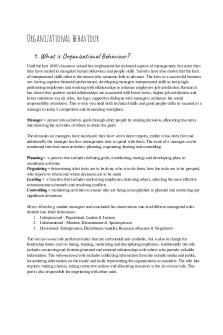
Organizational behaviour
- 67 Pages

Organizational Behaviour
- 2 Pages
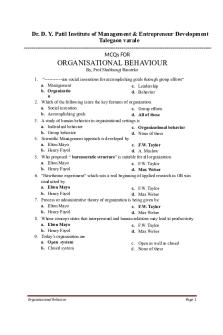
Organizational Behaviour mcqs
- 27 Pages
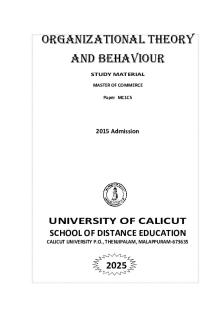
Organizational theory and behaviour
- 186 Pages
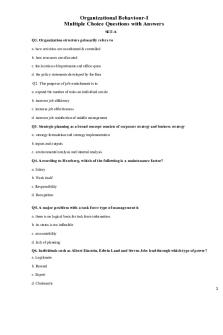
Organizational Behaviour MCQ SET
- 20 Pages
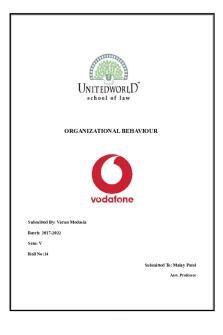
Organizational Behaviour Project
- 15 Pages

Chapter 2 ORGANIZATIONAL BEHAVIOUR
- 23 Pages
Popular Institutions
- Tinajero National High School - Annex
- Politeknik Caltex Riau
- Yokohama City University
- SGT University
- University of Al-Qadisiyah
- Divine Word College of Vigan
- Techniek College Rotterdam
- Universidade de Santiago
- Universiti Teknologi MARA Cawangan Johor Kampus Pasir Gudang
- Poltekkes Kemenkes Yogyakarta
- Baguio City National High School
- Colegio san marcos
- preparatoria uno
- Centro de Bachillerato Tecnológico Industrial y de Servicios No. 107
- Dalian Maritime University
- Quang Trung Secondary School
- Colegio Tecnológico en Informática
- Corporación Regional de Educación Superior
- Grupo CEDVA
- Dar Al Uloom University
- Centro de Estudios Preuniversitarios de la Universidad Nacional de Ingeniería
- 上智大学
- Aakash International School, Nuna Majara
- San Felipe Neri Catholic School
- Kang Chiao International School - New Taipei City
- Misamis Occidental National High School
- Institución Educativa Escuela Normal Juan Ladrilleros
- Kolehiyo ng Pantukan
- Batanes State College
- Instituto Continental
- Sekolah Menengah Kejuruan Kesehatan Kaltara (Tarakan)
- Colegio de La Inmaculada Concepcion - Cebu

